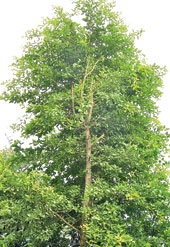 |
Eppurathu Vasudevan Soniya had a bael tree in the backyard of the house she grew up in at Thrissur, in central Kerala, but she really can’t claim to have been well acquainted with it. Yet the bael tree (scientific name Aegle marmelos) may well prove to be a milestone in the 16-year scientific career of this plant molecular biologist at the Rajiv Gandhi Centre for Biotechnology (RGCB) in Thiruvananthapuram.
Last month, a team of researchers led by Soniya hit a scientific jackpot of sorts when they reported that the leaves of the bael tree carry an enzyme that can yield compounds that have significant therapeutic potential. The tree grows across India as well as in many other south Asian countries. The bael is considered holy by Hindus. Its leaves are required for worship. It is also considered a favourite of Shiva.
The RGCB scientists, working with the National Institute of Immunology (NII) in New Delhi, not only identified the bioactive molecule, quinolone synthase, but also identified the gene responsible for its production in the plant. The discovery, reported in the Journal of Biological Chemistry recently, seems to have the potential to yield a new class of antibiotic and anti-cancer drugs.
The biomolecule that they studied belongs to a class of multifunctional proteins involved in the biosynthesis of diverse types of natural compounds. Called polyketides, these molecules are much sought after by bugs and drug designers alike.
Microorganisms like bacteria and fungi produce polyketides so that they can create complex molecules that are essential for their survival, and sometimes even to kill their predators. For instance, the TB-causing mycobacterium tuberculosis exploits these enzymes to synthesise complex lipids, many of which are essential for their virulence.
The pharmaceutical industry, on the other hand, has developed a large number of drugs that mimic the anti-microbial properties of polyketides. It is estimated that, worldwide, polyketide-based drugs account for more than US$35 billion in sales annually. They include antibiotics such as tetracycline and erythromycin, anti-cancer drugs used in chemotherapy such as mithramycin and doxorubicin and drugs like Zocor used for lowering cholesterol. Another prominent drug derived from a polyketide is rapamycin, widely used as an immunosuppressant when an organ transplant is carried out.
“Quite like microbes, plants too keep a large array of polyketides. Unlike animals that can run away from threats and predators, plants have no choice but have ingenious ways of fighting them. Polyketides seem to be one such weapon in their arsenal,” says Soniya. Many popular plant bioactive molecules such as gingerol in ginger, curcumin in turmeric and resveratrol found in grapes are produced by polyketides.
The formation of polyketides by microorganisms is fairly well known. Polyketides make some unusual molecules which have found their way to commercial production owing to their potential applications, says Rajesh Gokhale, director of the Institute of Genomics and Integrative Biology in New Delhi, who helped the RGCB scientists in finding the enzyme. “This is a significant study because it offers a unique insight into how these biologically important molecules are made in nature by this enzyme,” says Gokhale, a co-author of the work.
Soniya says she chanced upon the bael accidentally. “We were looking for polyketides in another plant, but the effort failed to yield any success. As a result, we turned to bael some five years ago,” Soniya told Knowhow.
Bael has been very popular among ayurveda practitioners for a long time. Many ayurvedic preparations use the leaves and fruit of bael. However, this is possibly the first serious attempt to analyse an active compound from this plant using modern scientific tools.
“We think that the enzyme we characterised — quinolone synthase — is equally capable of producing two pharmacologically active molecules,” explains the RGCB scientist. While acridone exhibits anti-cancer properties, quinolone is a base for a broad spectrum of antibiotics, which have been in use for more than half a century.
“It is true that we have found the gene responsible for the production of this enzyme. We still need to unravel its structure completely before we know whether it can be tweaked to exploit its medicinal properties,” she says. “It is still very early days,” Soniya says of the work, which is part of a doctoral project by her student, Mohankumar Saraladevi Resmi.
“What it allows us to do now is to convert this one molecule to another one through mutation studies and increase their availability outside the plant through the synthetic biology route,” says Gokhale.











